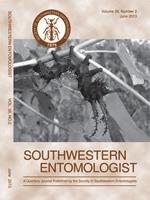The aim of this study was to evaluate the pathogenicity and virulence of 16 native isolates and three collection strains of three species of entomopathogenic fungi that may have the potential for affecting Asian citrus psyllid nymphs, Diaphorina citri Kuwayama (Hemiptera: Liviidae), by developing an effective methodology for their evaluation. Bioassays were conducted in a laboratory using shoots of Citrus aurantium L., infested with second to fifth instar D. citri nymphs placed in Petri dishes and sprayed with 1 × 108 conidia mL-1 suspensions of the entomopathogenic fungi Beauveria bassiana, Isaria fumosorosea, and Metarhizium brunneum. Infested insects were incubated in a growth chamber at 26 ± 2°C, 60 ± 5% relative humidity, and 16:8 lightdark hours. The results showed that /. fumosorosea Pfr-612 strain scored the highest mortality (84.2%), while the isolate HIB-14 of B. bassiana induced the development of mycosis more effectively on psyllid nymphs.
How to translate text using browser tools
1 June 2013
Patogenicity of Native Entomopathogenic Fungi from the Mexican Citrus-Growing Area against Diaphorina citri Kuwayama (Hemiptera: Liviidae)
Fatima Lizeth Gandarilla-Pacheco,
José I. López-Arroyo,
Luis J. Galán-Wong,
Isela Quintero-Zapata
ACCESS THE FULL ARTICLE

Southwestern Entomologist
Vol. 38 • No. 2
June 2013
Vol. 38 • No. 2
June 2013




